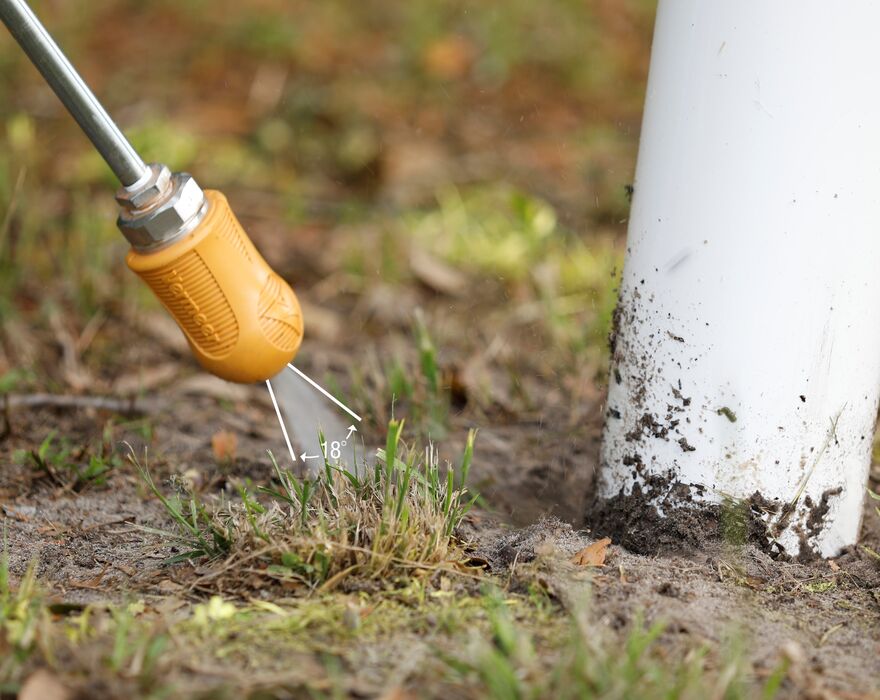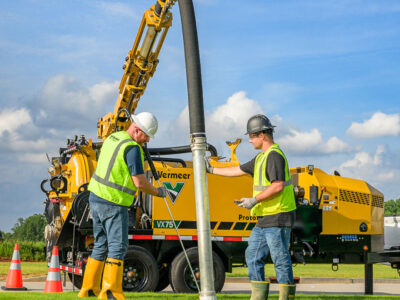The demand for vacuum excavation has surged in recent years as more contractors and municipalities discover the efficiency benefits of soft excavation methods. For those new to this equipment, the choices can seem overwhelming. This FAQ addresses common questions about trailer-mounted vacuum excavators to help you determine if they’re the right solution for your needs.
What is a vacuum excavator used for?
Vacuum excavators provide a non-destructive method of digging that combines high-pressure water or air with powerful suction to remove soil and debris. Common applications include:
- Potholing/daylighting: Exposing buried utilities to verify their location before excavation
- Digging: Non-destructive excavation around sensitive underground infrastructure
- Horizontal directional drill (HDD) support: Managing drilling fluids during HDD operations
- Slot/hydro-trenching: Creating narrow trenches for utility installation
- Sign and pole installation: Digging precise holes for posts and poles
- Debris removal: Cleaning up wet or dry materials from various sites
- Municipal maintenance: Cleaning catch basins, valve boxes and other infrastructure
- Water main and valve repair: Exposing infrastructure for maintenance without damaging surroundings
- Excavation in tight spaces: Accessing areas where traditional equipment cannot operate
- Foundation and footing work: Precise digging for structural elements
- Landscaping: Soil removal and bed preparation with minimal disruption
More and more contractors rely on this equipment, especially in busy underground areas where digging with regular equipment could damage utility lines.
What are the different types of vacuum excavators available?
Vacuum excavators come in several configurations, each designed to meet specific operational needs:
- Trailer vacuum excavators are mounted on trailers that can be towed behind trucks or other vehicles. These units are popular for their lower initial cost and versatility. They can be left at jobsites while the towing vehicle is used elsewhere and are available in various tank sizes to support different applications.
- Truck vacuum excavators (PTO) use the truck’s engine power through a power take-off system to drive the vacuum and water systems. This integrated design eliminates the need for a separate engine, allowing for larger tank capacities on a shorter truck frame and providing excellent maneuverability in urban environments.
- Truck-mounted vacuum excavators feature a skid-mounted vacuum system with its own power source that’s installed on a truck chassis. These systems operate independently of the truck engine and offer flexibility but add weight to the truck, which can affect payload capacity.
- Skid-mounted vacuum excavators are self-contained units that can be placed in truck beds or other carrying platforms. These systems can be moved between different carrying vehicles as needed.
When should I use a trailer vacuum excavator versus a truck-mounted or PTO unit?
Trailer vacuum excavators offer several advantages that make them ideal for certain applications:
- Lower initial investment: Trailer vacs generally have a more affordable upfront cost compared to truck-mounted or PTO units.
- Versatility: You can pull a trailer vac with different vehicles or leave it at the jobsite while using the truck for other tasks.
- Ideal for multiple job locations: If your crews work at several spread-out locations, multiple trailer vacs may be more efficient than a single large truck vac.
- Suited for smaller jobs: For potholing work and smaller utility projects, trailer vacs provide the necessary capabilities without the expense of larger equipment.
Truck-mounted and PTO vacuum excavators, on the other hand, excel in situations requiring:
- Larger tank capacities for extended operation without dumping
- Better maneuverability in tight urban environments
- Higher productivity for dedicated vacuum excavation work
What’s the difference between hydro and air vacuum excavation?
Vacuum excavators use two primary methods for breaking up soil:
Hydro-excavation:
- Uses pressurized water to cut through soil and break up material
- More effective in most soil types, especially clay and compacted soils
- Requires water supply and produces wet spoils that are heavier
- Typically faster excavation rates in most ground conditions
Air excavation:
- Uses compressed air instead of water to loosen soil
- Ideal for dry, sandy soils
- Produces dry spoils that can often be reused or lighter to transport
While most trailer vacuum excavators in the market are hydro models, some manufacturers offer combination units that provide both capabilities.
What size spoil tank do I need?
Spoil tank capacity is a critical consideration that depends on your typical applications:
- 300 gal – 500 gal (1,135 L – 1,893 L): Suitable for smaller utility potholing jobs where water usage is minimal and dump sites are accessible
- 500 gal – 800 gal (1,893 L – 3,028 L): The sweet spot for most contractors supporting HDD operations and doing moderate potholing work
- 800 gal – 1,200 gal (3,028 L – 4,542 L): Appropriate for extensive potholing, challenging soil conditions or situations where dump sites are distant
When selecting tank size, consider job duration, soil conditions, transportation requirements and water-to-spoil ratio.
What CFM (cubic feet per minute) and hose size do I need?
CFM refers to the volume of air being moved by the vacuum system and directly correlates with hose diameter. Selecting the right combination is essential for efficient operation:
- 3-in (7.6-cm) hose with 500 CFM – 580 CFM (14.2 m³/min – 16.4 m³/min): Ideal for potholing and most utility locating applications.
- 4-in (10.2-cm) hose with 1,000+ CFM (28.3+ m³/min): Better for challenging ground conditions.
The key is maintaining enough velocity to keep material suspended in the airflow from excavation point to tank. If material settles in the hose, you risk clogs and lost productivity.
Should I choose a gas or diesel engine?
Both gas and diesel engines have their place in vacuum excavation equipment:
Gas-powered units:
- Lower initial purchase price
- Easier starting in cold weather (with EFI systems)
- Comparable performance to diesel in 3-in and 4-in (7.6-cm and 10.2 cm)) a hose categories
- Often lighter weight, providing more capacity for spoil material
Diesel-powered units:
- Typically longer engine life
- Typically high resale value
- Superior performance in larger vacuum excavator categories
- Often preferred for full-time potholing operations
What accessories should I consider for my vacuum excavator?
Several accessories can significantly enhance the functionality of your vacuum excavator:
- Hydraulic booms: Make hose handling easier and allow for single-person operation
- Strong Arm® support: An economical alternative to booms that still provides support for the vacuum hose
- Jetter options: Allows cleaning of lateral lines and sewer systems
- Valve exercisers: Helpful for municipal water system maintenance
- Hot boxes: Warms water for more effective digging in colder conditions
How important is the potholing nozzle selection?
The potholing nozzle at the end of your water wand significantly impacts both digging performance and water usage:
- Nozzle sizing: Match your nozzle size to your water pump’s capabilities. A nozzle that’s too small won’t utilize your pump’s full potential, while one that’s too large can reduce pressure.
- Spray pattern: An 18-degree rotating cone pattern provides efficient cutting power while minimizing the risk of utility damage.
- Water efficiency: Specialized nozzles like the Vermeer QuickDig™ nozzle can help improve digging efficiency by up to 35%* compared to standard rotary nozzles, reducing water usage and extending time between refills.
*Claims of performance provided by third-party manufacturer. Individual results may vary based on care and operation of equipment and ground conditions, which may adversely affect performance.

What safety considerations and PPE are important when operating vacuum excavators?
Safety should always be a priority when operating vacuum excavation equipment:
- Proper training: Make certain all operators understand equipment operation
- Personal protective equipment (PPE): Always wear appropriate PPE which may include eye protection, gloves, hard hat and proper footwear
- Jobsite awareness: Inspect work areas for overhead and underground utilities before beginning work
- Pressure management: Never exceed manufacturer recommended PSI
- Maintain distance: Maintain proper distances from open excavations and when operating the tank door
When working near electrical utilities, make sure operators wear appropriate dialectic boots.
How do I maintain my vacuum excavator for optimal performance?
Regular maintenance is critical for long equipment life and reliable performance:
- Check fluid levels daily (engine oil, hydraulic oil, coolant, blower oil and water pump oil)
- Monitor the vacuum gauge for signs of dirty filters or full tanks
- Clean filters regularly and have spares on hand
- Flush and clean the spoil tank after use to prevent material buildup
- Inspect hoses and connections for wear or damage
- Follow manufacturer-recommended service intervals
What training do operators need?
Proper training is essential for efficient vacuum excavator operation. New operators should receive:
- Hands-on equipment orientation covering all controls and functions
- Safety protocols for various working environments
- Proper potholing techniques to avoid utility damage
- Basic troubleshooting and maintenance procedures
- Understanding of ground disturbance and utility marking systems
Many manufacturers and dealers offer training programs for new operators. Investing in proper training can help improve efficiency and extends equipment life through proper operation.
Where can I purchase a vacuum excavator?
When you’re ready to add a vacuum excavator to your fleet, working with an established dealer network provides important advantages:
- Equipment expertise to help select the right model for your applications
- Ongoing service support after the sale
- Parts availability to help minimize downtime
- Training resources for your operators
- Financing options to fit your business needs
Ready to see how a vacuum excavator can improve your operations? Find your nearest Vermeer dealer today to learn more about these versatile excavation solutions.
Vermeer MV Solutions, Inc. reserves the right to make changes in engineering, design and specifications; add improvements, or discontinue manufacturing at any time without notice or obligation. Equipment shown is for illustrative purposes only and may display optional accessories or components specific to their global region. Please contact your local Vermeer dealer for more information on machine specifications. Vermeer, the Vermeer logo, QuickDig and Strong Arm are trademarks of Vermeer Manufacturing Company in the U.S. and/or other countries. © 2025 Vermeer MV Solutions, Inc. All Rights Reserved.
